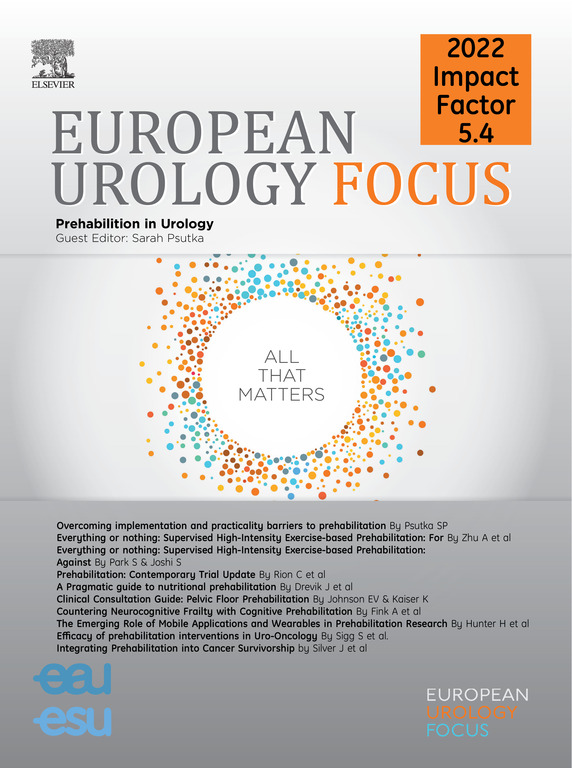肾脏环境参数对尿路致病性大肠杆菌抗生素疗效的影响
IF 5.6
2区 医学
Q1 UROLOGY & NEPHROLOGY
引用次数: 0
摘要
背景和目的:尿路感染(UTI)是影响泌尿系统的常见感染,主要由细菌病原体引起,其中大肠杆菌是最常见的病原体。由于特殊的组织微环境,肾脏感染(如肾盂肾炎)非常严重,治疗难度很大。本研究分析了模拟肾脏环境的不同参数对肾盂肾炎处方抗生素对尿路病原菌生长效果的影响:为了研究模拟肾脏环境的不同因素的影响,我们测试了不同肾脏代表浓度的氯化钠和尿素以及不同pH值对厄他培南、左氧氟沙星和头孢曲松疗效的影响。通过确定对不同大肠杆菌菌株的最小抑菌浓度(MICs)来评估疗效:研究表明,pH 值对左氧氟沙星的 MIC 值有很大影响。pH 值变酸会导致 MIC 值增加,而 pH 值变碱则会产生相反的效果。氯化钠和尿素浓度的影响与菌株和抗生素有关。由于本研究测试了三种不同的抗生素,因此有必要对更多抗生素进行进一步研究:这些结果表明,肾脏内的理化条件会在很大程度上影响肾盂肾炎抗生素治疗的成功率。因此,临床医生在选择和使用抗生素时必须考虑这些因素。为了更全面地了解肾脏环境如何影响抗菌药物的活性,我们需要开展进一步的研究,评估更广泛的抗生素和更多的环境参数。这些知识对优化肾盂肾炎的治疗策略至关重要,最终将改善患者的预后。患者总结:肾脏内的理化条件影响着肾盂肾炎抗生素治疗的成功与否。我们的研究结果对优化治疗策略至关重要,最终将改善患者的预后。本文章由计算机程序翻译,如有差异,请以英文原文为准。
Influence of Kidney Environment Parameters on Antibiotic Efficacy Against Uropathogenic Escherichia coli
Background and objective
Urinary tract infections (UTIs) are common infections affecting the urinary system, predominantly caused by bacterial pathogens, with Escherichia coli being the most frequent pathogen. Infections of the kidney (eg, pyelonephritis) are severe and challenging to treat, due to the specific tissue microenvironment. In this study, the influence of different parameters mimicking the kidney environment on the effectiveness of antibiotics prescribed for pyelonephritis on the growth of uropathogenic strains was analyzed.
Methods
To investigate the influence of different factors mimicking the kidney environment, we tested the effect of different kidney-representative concentrations of sodium chloride and urea, and different pH values on the efficacy of ertapenem, levofloxacin, and ceftriaxone. The effectiveness was assessed by determining the minimal inhibitory concentrations (MICs) against various E. coli strains.
Key findings and limitations
The study revealed that pH significantly influences the MIC values of levofloxacin. Acidification of the pH led to an increase of the MIC values, while an alkaline pH had the opposite effect. The influence of sodium chloride and urea concentrations was strain and antibiotic specific. Since three different antibiotics were tested in this study, further research with additional antibiotics is warranted.
Conclusions and clinical implications
These results suggest that the physicochemical conditions within the kidney can substantially influence the success of antibiotic therapy for pyelonephritis. Therefore, it is crucial for clinicians to consider these factors when selecting and dosing antibiotics. Further research is needed to evaluate a broader range of antibiotics and additional environmental parameters, to develop a more comprehensive understanding of how the kidney environment affects antimicrobial activity. This knowledge will be vital in optimizing treatment strategies for pyelonephritis, ultimately improving patient outcomes.
Patient summary
The physicochemical conditions within the kidney influence the success of antibiotic therapy for pyelonephritis. Our findings are vital in optimizing treatment strategies and will ultimately improve patient outcomes.
求助全文
通过发布文献求助,成功后即可免费获取论文全文。
去求助
来源期刊

European urology focus
Medicine-Urology
CiteScore
10.40
自引率
3.70%
发文量
274
审稿时长
23 days
期刊介绍:
European Urology Focus is a new sister journal to European Urology and an official publication of the European Association of Urology (EAU).
EU Focus will publish original articles, opinion piece editorials and topical reviews on a wide range of urological issues such as oncology, functional urology, reconstructive urology, laparoscopy, robotic surgery, endourology, female urology, andrology, paediatric urology and sexual medicine. The editorial team welcome basic and translational research articles in the field of urological diseases. Authors may be solicited by the Editor directly. All submitted manuscripts will be peer-reviewed by a panel of experts before being considered for publication.
 求助内容:
求助内容: 应助结果提醒方式:
应助结果提醒方式:


